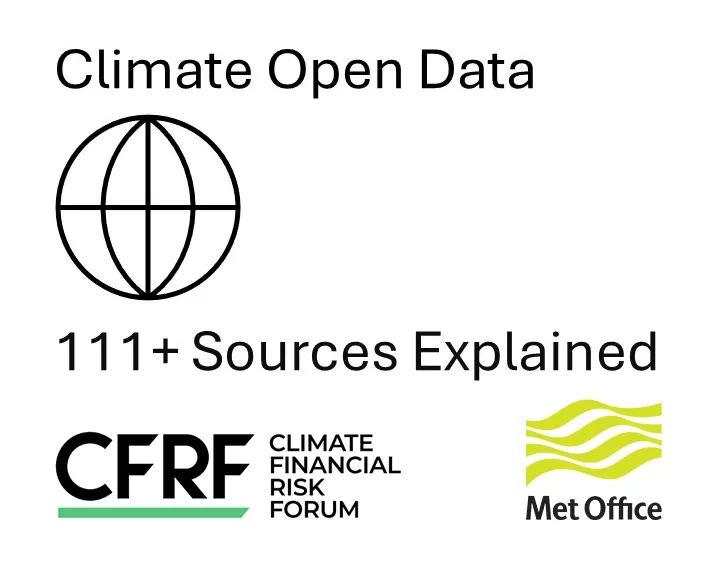Climate Data 111+ is a comprehensive database that can be used by researchers, policymakers, urban planners, risk managers, financial institutions, educators, non-profit organisations, environmental consultants, disaster response teams, infrastructure developers, public health officials, and others for climate risk assessment, adaptation planning, policy development, and resilient infrastructure design. Each data source is described with a detailed and standardised set of attributes, ensuring that users can easily understand and compare the data.

Introduction
Climate Data 111+ is detailed in several dimensions and provides a thorough understanding of the scope, quality and applicability of the data. Descriptions include the specific climate hazards covered, such as floods, droughts, heatwaves, or wildfires; the relevant time period (historical, present, or future); and the frequency of data collection or updates, ranging from hourly to yearly intervals. The geographic area covered by the data is specified, from local to global scales, and the level of detail in the spatial data is indicated, including the source's native resolution and the approximate spatial resolution standardised to kilometres for easy comparison across sources.
Climate Data 111+ also includes advanced attributes. Information on the type of ensemble used, such as Scenario Ensembles, Initial Condition Ensembles, or Parameter Ensembles, helps users understand the robustness and variability captured in the data. Additionally, the climate scenarios included in the data, ranging from business-as-usual to various mitigation pathways, are detailed, along with any post-processing applied, including bias correction, spatial and/or temporal aggregation, and ensemble aggregation.
To facilitate data accessibility and usability, Climate Data 111+ includes key indicators or metrics provided by the data source. Information on the recency and update frequency of the data ensures users have access to the latest information. The format in which the data is available, such as CSV, NetCDF, or JSON, is also specified.
Comprehensive metadata is provided to facilitate data sourcing and credibility assessment. This includes the organisation or institution responsible for the data, which provides context for regional expertise and focus, and direct links to access the data or more information about the source.
Climate Data 111+ focuses on open access sources, allowing users to access high-quality data without any cost.
Addressing CFRF Needs
The Climate Financial Risk Forum (CFRF) Adaptation Working Group highlights the need for improved climate risk analysis and adaptation strategies. Climate Data 111 + addresses some of these needs by providing open access data sources for risk assessments and translating global emission scenarios into actionable local hazards data. Climate Data 111+ provides structured guidance on the integration of scenario analysis into investment, lending and underwriting decisions and meets CFRF's call for improved guidance.
Use Cases Examples
Climate Data 111+ is valuable for a wide range of users. Researchers can use it to support climate science research. Policymakers benefit from data-driven, evidence-based decision-making. Urban planners and infrastructure developers design resilient infrastructure, enhancing city sustainability. Risk managers in finance can find valuable sources to assess and mitigate climate risks. Educators use it to promote awareness and proactive responses to climate challenges. Non-profit organisations base advocacy and climate action projects on reliable data. Environmental consultants offer expert advice with tailored solutions. Disaster response teams improve planning and response strategies, enhancing resilience. Public health officials plan for and mitigate climate-related health impacts, protecting communities and etc.
Prepared with funding support from:

This information was researched, validated and enriched by combining information from various web, map and reporting sources. Please contact Dr Anna Freeman to inform us of any errors, omissions or for other feedback.
The list is compiled on a best-efforts basis and is not exhaustive. Inclusion on the list does not indicate use of or endorsement by the CFRF, University of Oxford, Met Office, or partners.
Disclaimer
This tool is designed to provide valuable information to support your understanding of climate data. While it offers a comprehensive resource, we recommend consulting with a professional or specialist to get tailored advice for your specific needs and actions based on this content.
We strive to keep the information on our site current and accurate, but we encourage users to verify details and seek expert guidance as needed. The University of Oxford is committed to offering high-quality resources but cannot accept liability for any issues or consequences arising from the use of this data or tool.
Licence and Attribution
The data can be used by others and is available under a CC BY 4.0 licence.
Suggested citation:
Freeman, A., Ranger, N., Bernhofen, M., Szczepanski, M., Lowe, J., Holmes, I., Bremner, C., & Harwood, T. (2024). Climate Data 111+: Synthesis of Hazard Data Sources for Physical Climate Risk Assessment and Adaptation, Version 1 (June 2024). Environmental Change Institute, University of Oxford. DOI: 10.5287/ora-brgkzjedb
Download Toolkit
Climate Data 111+: Synthesis of Hazard Data Sources (Version 1).
